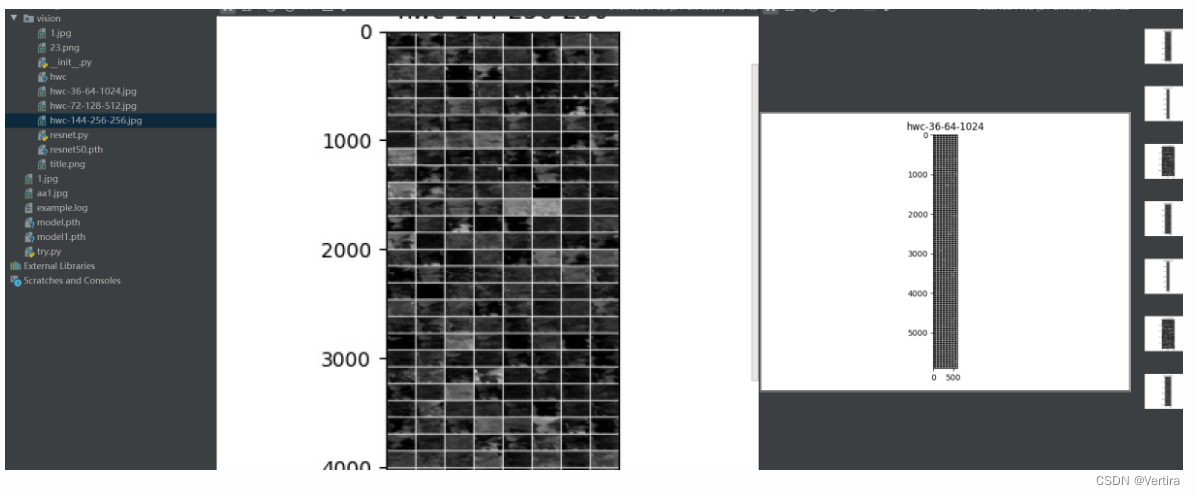1.特征图可视化,这种方法是最简单,输入一张照片,然后把网络中间某层的输出的特征图按通道作为图片进行可视化展示即可。
2.特征图可视化代码如下:
def featuremap_visual(feature, out_dir=None, # 特征图保存路径文件save_feature=True, # 是否以图片形式保存特征图show_feature=True, # 是否使用plt显示特征图feature_title=None, # 特征图名字,默认以shape作为titlenum_ch=-1, # 显示特征图前几个通道,-1 or None 都显示nrow=8, # 每行显示多少个特征图通道padding=10, # 特征图之间间隔多少像素值pad_value=1 # 特征图之间的间隔像素):import matplotlib.pylab as pltimport torchvisionimport os# feature = feature.detach().cpu()b, c, h, w = feature.shapefeature = feature[0]feature = feature.unsqueeze(1)if c > num_ch > 0:feature = feature[:num_ch]img = torchvision.utils.make_grid(feature, nrow=nrow, padding=padding, pad_value=pad_value)img = img.detach().cpu()img = img.numpy()images = img.transpose((1, 2, 0))# title = str(images.shape) if feature_title is None else str(feature_title)title = str('hwc-') + str(h) + '-' + str(w) + '-' + str(c) if feature_title is None else str(feature_title)plt.title(title)plt.imshow(images)if save_feature:# root=r'C:\Users\Administrator\Desktop\CODE_TJ\123'# plt.savefig(os.path.join(root,'1.jpg'))out_root = title + '.jpg' if out_dir == '' or out_dir is None else os.path.join(out_dir, title + '.jpg')plt.savefig(out_root)if show_feature: plt.show()
3.结合resnet网络整体可视化(主要将其featuremap_visual函数插入forward中,即可),整体代码如下:
resnet网络结构在我博客:
残差网络ResNet(超详细代码解析) :你必须要知道backbone模块成员之一 - tangjunjun - 博客园
"""
@author: tangjun
@contact: 511026664@qq.com
@time: 2020/12/7 22:48
@desc: 残差ackbone改写,用于构建特征提取模块
"""import torch.nn as nn
import torch
from collections import OrderedDictdef Conv(in_planes, out_planes, **kwargs):"3x3 convolution with padding"padding = kwargs.get('padding', 1)bias = kwargs.get('bias', False)stride = kwargs.get('stride', 1)kernel_size = kwargs.get('kernel_size', 3)out = nn.Conv2d(in_planes, out_planes, kernel_size=kernel_size, stride=stride, padding=padding, bias=bias)return outclass BasicBlock(nn.Module):expansion = 1def __init__(self, inplanes, planes, stride=1, downsample=None):super(BasicBlock, self).__init__()self.conv1 = Conv(inplanes, planes, stride=stride)self.bn1 = nn.BatchNorm2d(planes)self.relu = nn.ReLU(inplace=True)self.conv2 = Conv(planes, planes)self.bn2 = nn.BatchNorm2d(planes)self.downsample = downsampleself.stride = stridedef forward(self, x):residual = xout = self.conv1(x)out = self.bn1(out)out = self.relu(out)out = self.conv2(out)out = self.bn2(out)if self.downsample is not None:residual = self.downsample(x)out += residualout = self.relu(out)return outclass Bottleneck(nn.Module):expansion = 4def __init__(self, inplanes, planes, stride=1, downsample=None):super(Bottleneck, self).__init__()self.conv1 = nn.Conv2d(inplanes, planes, kernel_size=1, bias=False)self.bn1 = nn.BatchNorm2d(planes)self.conv2 = nn.Conv2d(planes, planes, kernel_size=3, stride=stride,padding=1, bias=False)self.bn2 = nn.BatchNorm2d(planes)self.conv3 = nn.Conv2d(planes, planes * 4, kernel_size=1, bias=False)self.bn3 = nn.BatchNorm2d(planes * 4)self.relu = nn.ReLU(inplace=True)self.downsample = downsampleself.stride = stridedef forward(self, x):residual = xout = self.conv1(x)out = self.bn1(out)out = self.relu(out)out = self.conv2(out)out = self.bn2(out)out = self.relu(out)out = self.conv3(out)out = self.bn3(out)if self.downsample is not None:residual = self.downsample(x)out += residualout = self.relu(out)return outclass Resnet(nn.Module):arch_settings = {18: (BasicBlock, (2, 2, 2, 2)),34: (BasicBlock, (3, 4, 6, 3)),50: (Bottleneck, (3, 4, 6, 3)),101: (Bottleneck, (3, 4, 23, 3)),152: (Bottleneck, (3, 8, 36, 3))}def __init__(self,depth=50,in_channels=None,pretrained=None,frozen_stages=-1# num_classes=None):super(Resnet, self).__init__()self.inplanes = 64self.inchannels = in_channels if in_channels is not None else 3 # 输入通道# self.num_classes=num_classesself.block, layers = self.arch_settings[depth]self.frozen_stages = frozen_stagesself.conv1 = nn.Conv2d(self.inchannels, 64, kernel_size=7, stride=2, padding=3, bias=False)self.bn1 = nn.BatchNorm2d(64)self.relu = nn.ReLU(inplace=True)self.maxpool = nn.MaxPool2d(kernel_size=3, stride=2, padding=1)self.layer1 = self._make_layer(self.block, 64, layers[0], stride=1)self.layer2 = self._make_layer(self.block, 128, layers[1], stride=2)self.layer3 = self._make_layer(self.block, 256, layers[2], stride=2)self.layer4 = self._make_layer(self.block, 512, layers[3], stride=2)# self.avgpool = nn.AvgPool2d(7)# self.fc = nn.Linear(512 * self.block.expansion, self.num_classes)self._freeze_stages() # 冻结函数if pretrained is not None:self.init_weights(pretrained=pretrained)def _freeze_stages(self):if self.frozen_stages >= 0:self.norm1.eval()for m in [self.conv1, self.norm1]:for param in m.parameters():param.requires_grad = Falsefor i in range(1, self.frozen_stages + 1):m = getattr(self, 'layer{}'.format(i))m.eval()for param in m.parameters():param.requires_grad = Falsedef init_weights(self, pretrained=None):if isinstance(pretrained, str):self.load_checkpoint(pretrained)elif pretrained is None:for m in self.modules():if isinstance(m, nn.Conv2d):nn.init.kaiming_normal_(m.weight, a=0, mode='fan_out', nonlinearity='relu')if hasattr(m, 'bias') and m.bias is not None: # m包含该属性且m.bias非None # hasattr(对象,属性)表示对象是否包含该属性nn.init.constant_(m.bias, 0)elif isinstance(m, nn.BatchNorm2d):m.weight.data.fill_(1)m.bias.data.zero_()def load_checkpoint(self, pretrained):checkpoint = torch.load(pretrained)if isinstance(checkpoint, OrderedDict):state_dict = checkpointelif isinstance(checkpoint, dict) and 'state_dict' in checkpoint:state_dict = checkpoint['state_dict']if list(state_dict.keys())[0].startswith('module.'):state_dict = {k[7:]: v for k, v in checkpoint['state_dict'].items()}unexpected_keys = [] # 保存checkpoint不在module中的keymodel_state = self.state_dict() # 模型变量for name, param in state_dict.items(): # 循环遍历pretrained的权重if name not in model_state:unexpected_keys.append(name)continueif isinstance(param, torch.nn.Parameter):# backwards compatibility for serialized parametersparam = param.datatry:model_state[name].copy_(param) # 试图赋值给模型except Exception:raise RuntimeError('While copying the parameter named {}, ''whose dimensions in the model are {} not equal ''whose dimensions in the checkpoint are {}.'.format(name, model_state[name].size(), param.size()))missing_keys = set(model_state.keys()) - set(state_dict.keys())print('missing_keys:', missing_keys)def _make_layer(self, block, planes, num_blocks, stride=1):downsample = Noneif stride != 1 or self.inplanes != planes * block.expansion:downsample = nn.Sequential(nn.Conv2d(self.inplanes, planes * block.expansion, kernel_size=1, stride=stride, bias=False),nn.BatchNorm2d(planes * block.expansion),)layers = []layers.append(block(self.inplanes, planes, stride, downsample))self.inplanes = planes * block.expansionfor i in range(1, num_blocks):layers.append(block(self.inplanes, planes))return nn.Sequential(*layers)def forward(self, x):outs = []x = self.conv1(x)x = self.bn1(x)x = self.relu(x)x = self.maxpool(x)x = self.layer1(x)outs.append(x)featuremap_visual(x)x = self.layer2(x)outs.append(x)featuremap_visual(x)x = self.layer3(x)outs.append(x)featuremap_visual(x)x = self.layer4(x)outs.append(x)# x = self.avgpool(x)# x = x.view(x.size(0), -1)# x = self.fc(x)return tuple(outs)def featuremap_visual(feature,out_dir=None, # 特征图保存路径文件save_feature=True, # 是否以图片形式保存特征图show_feature=True, # 是否使用plt显示特征图feature_title=None, # 特征图名字,默认以shape作为titlenum_ch=-1, # 显示特征图前几个通道,-1 or None 都显示nrow=8, # 每行显示多少个特征图通道padding=10, # 特征图之间间隔多少像素值pad_value=1 # 特征图之间的间隔像素):import matplotlib.pylab as pltimport torchvisionimport os# feature = feature.detach().cpu()b, c, h, w = feature.shapefeature = feature[0]feature = feature.unsqueeze(1)if c > num_ch > 0:feature = feature[:num_ch]img = torchvision.utils.make_grid(feature, nrow=nrow, padding=padding, pad_value=pad_value)img = img.detach().cpu()img = img.numpy()images = img.transpose((1, 2, 0))# title = str(images.shape) if feature_title is None else str(feature_title)title = str('hwc-') + str(h) + '-' + str(w) + '-' + str(c) if feature_title is None else str(feature_title)plt.title(title)plt.imshow(images)if save_feature:# root=r'C:\Users\Administrator\Desktop\CODE_TJ\123'# plt.savefig(os.path.join(root,'1.jpg'))out_root = title + '.jpg' if out_dir == '' or out_dir is None else os.path.join(out_dir, title + '.jpg')plt.savefig(out_root)if show_feature: plt.show()import cv2
import numpy as npdef imnormalize(img,mean=[123.675, 116.28, 103.53],std=[58.395, 57.12, 57.375],to_rgb=True):if to_rgb:img = cv2.cvtColor(img, cv2.COLOR_BGR2RGB)img = img.astype(np.float32)return (img - mean) / stdif __name__ == '__main__':import matplotlib.pylab as pltimg = cv2.imread('1.jpg') # 读取图片img = imnormalize(img)img = torch.from_numpy(img)img = torch.unsqueeze(img, 0)img = img.permute(0, 3, 1, 2)img = torch.tensor(img, dtype=torch.float32)img = img.to('cuda:0')model = Resnet(depth=50)model.init_weights(pretrained='./resnet50.pth') # 可以使用,也可以注释model = model.cuda()out = model(img)
运行结果

参考:
PyTorch模型训练特征图可视化 - tangjunjun - 博客园 (cnblogs.com)

)



)
